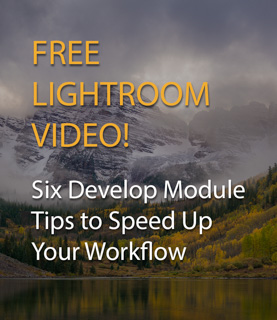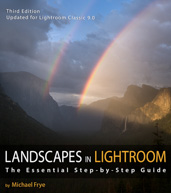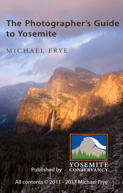Digital Darkroom
by Michael Frye | Aug 25, 2025 | Digital Darkroom
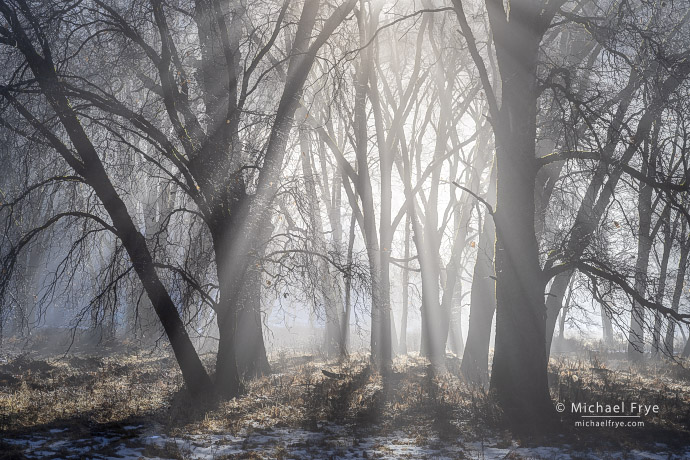
Oaks and mist, Yosemite NP, California. I love the light and fog in this scene, but couldn’t avoid including a distracting wire-mesh enclosure in the composition (see below).
Thanks to everyone who joined us for my Lightroom Webinar: Advanced Retouching on Saturday. It was an engaging, fun, and, I hope, educational session, and it was great to see so many familiar names among the attendees. I appreciate all the thoughtful questions, as they helped broaden the discussion and clarify many points.
One of the things we covered on Saturday was the pros and cons of AI-powered retouching in Lightroom – and how to work around the limitations. Generative Remove in Lightroom and Camera Raw, along with Generative Fill in Photoshop, have certainly made many retouching jobs a lot easier. But one thing that many people don’t realize is that these AI-powered tools can create low-resolution results. So when you remove an object with Generative Remove, that patch, that area where you replaced the object with AI-generated content, might look softer than its surroundings. That’s probably fine for posting an image online, because no one will notice that softness at a small viewing size. But it can be a significant problem when making prints.
(more…)
by Michael Frye | Aug 17, 2025 | Digital Darkroom, Photography Tips
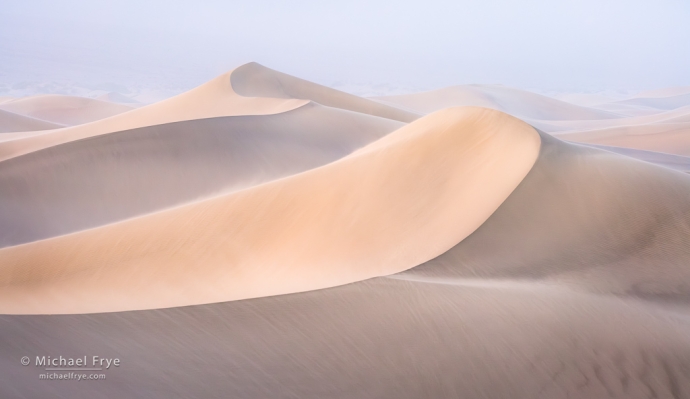
Dunes at sunrise in a sandstorm, Death Valley NP, California. During a dust storm, as you might expect, my sensor accumulated plenty of dust spots (see the next image below).
Removing dust spots from an image can be a tedious chore. Do you want to do that tiresome job twice? I certainly don’t – which is why I remove dust spots in Lightroom, rather than Photoshop.
There’s no way to do retouching in Photoshop in a completely flexible, non-destructive way that adapts to any further changes you make to the underlying layers. But when you remove a spot or object in Lightroom (or Camera Raw), the retouching will always adapt, no matter what you do to the image in the future. Even if you make a drastic change, like lightening the photo by two stops, making a big adjustment to the white balance, or converting it to black and white, the retouching in Lightroom will adapt and blend in seamlessly. And that means you’ll never, ever, have to do it again – which, for me, is a big advantage.
(more…)
by Michael Frye | Jul 11, 2025 | Announcements, Digital Darkroom
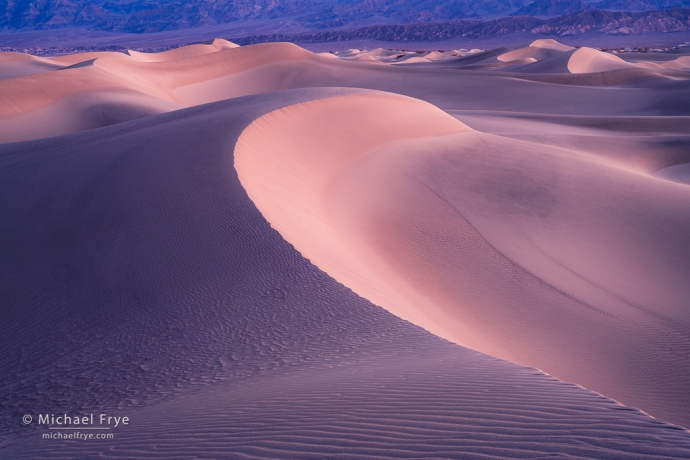
Make Your Workflow Faster and More Efficient By Mastering Lightroom’s Powerful Retouching Tools
Retouching can be a tedious chore. Even removing simple dust spots can be time-consuming, and more complex tasks take even longer. So the last thing you want is to do it over again! But unfortunately that’s always a possibility when you do retouching in Photoshop, even if you do it on a separate layer. What if you need to go back and modify the original raw file settings in Lightroom? Or what if Adobe adds a new feature for Lightroom (like a fantastic new Denoise tool) that you want to take advantage of? Now your cloning layer won’t match the new raw-file settings, and you’ll have to do the retouching over again.
But if you do the retouching in Lightroom you’ll NEVER have to do it again, because the retouching will always adapt seamlessly to any changes you make to the raw file – plus you can simplify your workflow by avoiding the roundtrip to Photoshop and back. This Lightroom-only workflow has become much easier in recent years as Adobe has added powerful new retouching tools to Lightroom, making it possible to do even complex jobs with relative ease. Because of Lightroom’s power and flexibility, I never do retouching in Photoshop anymore if I can possibly help it.
(more…)
by Michael Frye | Mar 4, 2025 | Digital Darkroom
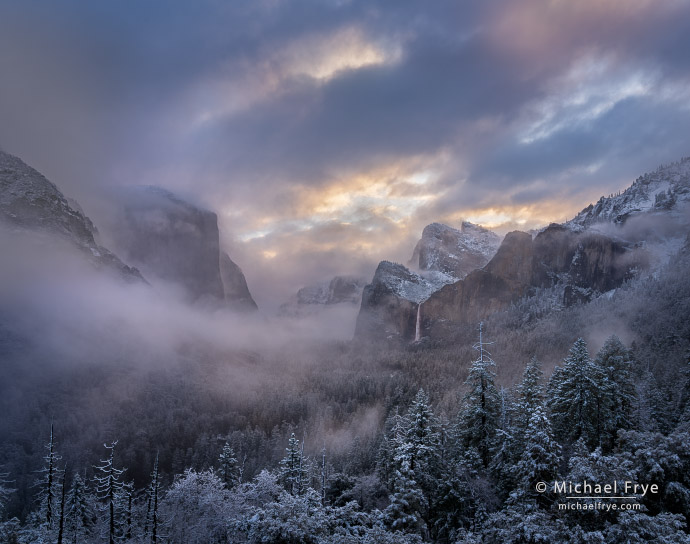
Winter sunrise from Tunnel View, Yosemite NP, California
After all our travels, Claudia and I are back home. Yesterday I drove up to Yosemite Valley before sunrise, as a small storm was clearing.
Looking at the weather models the night before, I didn’t have high hopes for this sunrise. Although I thought there could be a light dusting of snow, it appeared the storm would clear in the middle of the night, which usually means the fog and mist will dissipate by morning. But I set my alarm for 4:00 a.m. just in case. And when I awoke I could see that clouds and scattered showers had lingered all night, so there should still be some mist. And it also looked like skies would start clearing shortly after sunrise. So no going back to bed – time to go!
(more…)
by Michael Frye | May 22, 2024 | Digital Darkroom, Video Tutorials
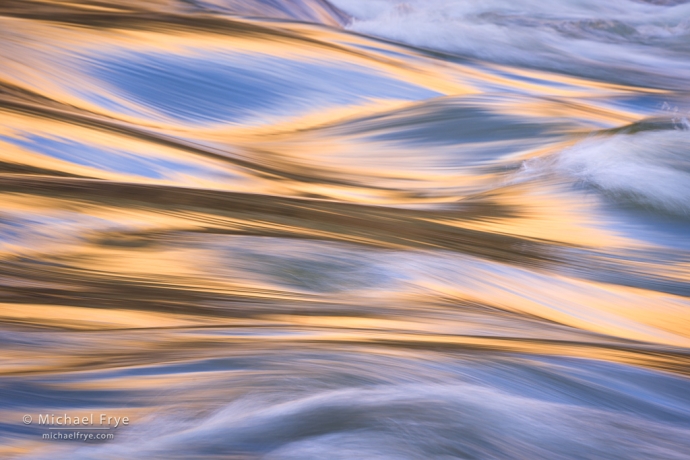
Rapid and reflections in the Colorado River, Grand Canyon NP, Arizona. The lower-right portion of this photograph had a large blemish caused by a water spot on the sensor. This would have been difficult to remove using traditional retouching tools in Lightroom or Photoshop, but took about five seconds with the new Generative-AI mode in Lightroom.
Yesterday Adobe announced significant upgrades to Lightroom, Lightroom Classic, and Camera Raw.
To me, the biggest news is the addition of “Generative AI” for retouching. This uses similar technology to Generative Fill in Photoshop, but isn’t designed to add or create things – only to remove objects. In fact Adobe changed the name of the Healing tool to the Remove tool.
Whatever you call it, Generative AI is a big leap forward in the retouching capabilities of Lightroom. It makes Lightroom almost as powerful as Photoshop for retouching, but unlike Photoshop it works in a completely flexible, non-destructive way. Generative AI does have some limitations, however, which I discuss below.
(more…)
by Michael Frye | Oct 19, 2023 | Digital Darkroom
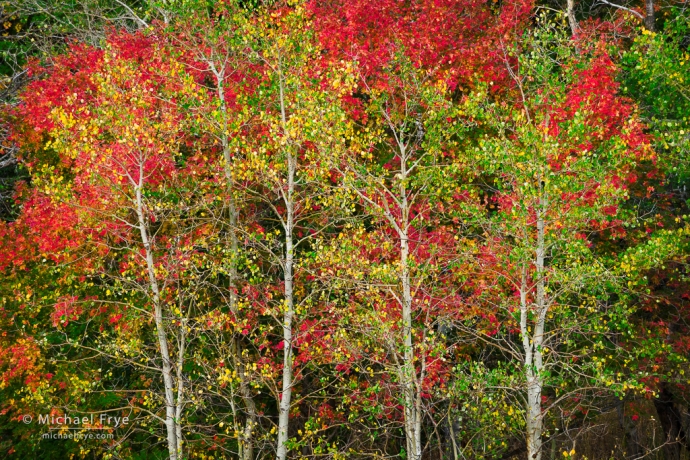
Aspens and bigtooth maples, northern Utah. I used the new Point Color tool to tweak the originally dull-looking greens and yellows in this photo and make them more vibrant.
Last week Adobe launched major updates to Lightroom Classic (13.0), Lightroom Desktop (7.0), and Lightroom Mobile (9.0). The biggest new features are HDR editing, Point Color, and Lens Blur.
All of these new tools deserve their own post, but we just finished a workshop, and we’re still traveling, so for now I’m just going to explain a few of the salient features, and steer you to some more in-depth information.
(more…)







